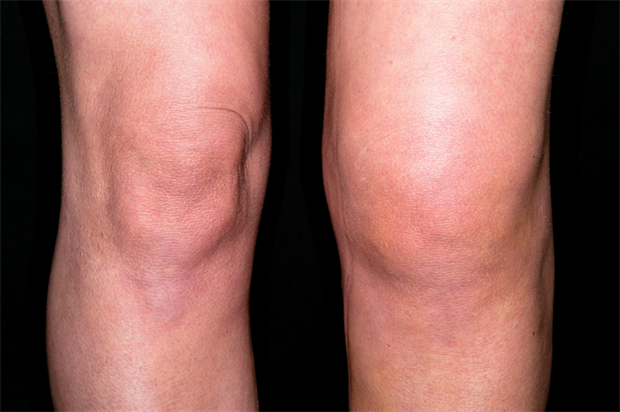A trauma to the knee, a ligament tear, arthritis, infections or even an overuse of the knee often leads to an accumulation of fluid around the knee joint. If this occurs, the affected knee will be swollen and appear larger than the other knee, painful to touch and in movement, stiff, bruised, etc. How to get rid of fluid on the knee? Depending on the underlying cause, you can get rid of excess fluid on the knee with at home treatments or medical treatments prescribed to you by a healthcare professional.

How to Get Rid of Fluid on the Knee?
If you have a problem with a swollen and painful knee, here are some tips that you can try to get rid of the excess fluid on the knee:
- Rest your knee and give it enough time to recover. Walk as little as possible and use crutches if it’s too painful to walk, straighten the leg or put the weight on it. Also, keeping your knee elevated while lying down will speed up the recovery process.
- Put some ice to reduce the swelling. You can repeat this process 3 times a day for about 20 minutes.
- Don’t apply heat on your knee for the first 48 hours. In cases of an injury, it is not recommended to apply heat on the affected knee for the first 48 hours as it will just make your condition worse. Stay away from hot showers or hot tubs as well.
- How to get rid of fluid on the knee? Apply a compression bandage as it will help decrease the swelling of your knee. Be careful and don’t wrap your knee to tight. In cases when you notice numbness, increased pain, a tingling sensation or even an odd coloring of the affected leg below the bandaged knee, you should release the bandage as these are all signs that your elastic bandage is wrapped too tight.
- Massage the affected knee to get rid of excess fluid at home. If you massage your knee gently you can reduce the swelling at home on your own as it will promote blood circulation. However, if it hurts when you massage it then you should probably stop.
- Over-the-counter painkillers can help you relieve the pain. Often, excessive fluid accumulation around the knee is accompanied by pain, stiffness, etc. In order to relieve the pain over-the-counter painkillers such as aspirin, ibuprofen, or acetaminophen can be very helpful.
When to See a Doctor and Medical Treatment Options
When to See a Doctor
If you have tried the above-mentioned measures at home and nothing seems to work than probably, it’s time to see a healthcare professional. If your knee is still swollen and doesn’t look better at all, then seeing a doctor is necessary. Also, you must see a doctor in cases when you notice signs of an infection such as redness, hotness of the affected knee and even high temperature.
How to get rid of fluid on the knee? It is always a good idea to consult a healthcare professional immediately after a knee injury or in cases when your knee starts swelling without a reason. A workup in such cases includes:
- Complete medical history and physical examination of the affected knee. Your doctor will want to know about the symptoms you noticed or how the injury occurred, when the symptoms started or when the injury occurred, recent activities, past injuries, any surgeries or other medical condition.
- X-ray of the affected knee, especially in cases of an injury to reveal any broken bone or dislocated bone
- Ultrasound of the affected knee to reveal any abnormalities in the bones, ligaments, tendons, and surrounding tissue
- MRI providing a better visualization of the knee structures
- Joint aspiration collecting some knee fluid for further analysis with the help of a needle
Depending on the findings, proper treatment is recommended or you might be referred to an orthopedist for further evaluation.
Treatment
How to get rid of fluid on the knee? The goal of the treatment is to reduce the swelling, relieve the pain, improve the function and knee movement, as well as, treat the underlying problem that has led to the collection of fluid on the knee.
Commonly recommended treatments include:
- Medications such as corticosteroids taken orally or injected into the affected joint in order to reduce the swelling as they are powerful anti-inflammatory medications
- Physical therapy involves certain types of exercises in order to increase the range of motion of the affected knee and to improve knee strength as well.
- Arthrocentesis is an elimination of knee fluid through needle aspiration in order to relieve the pressure and the pain.
- Arthroscopy is a procedure through which certain repairs on the affected knee joint can be done through a flexible tube with the camera, known as the arthroscope.
- Joint replacement is a surgical treatment considered in cases when all the other treatment options have failed. A prosthetic knee tends to improve the knee function and relieve the pain.
Are There Any Prevention Measures?
- If you are overweight or obese, you should lose some weight as extra weight puts more pressure on your knees.
- Avoiding rough running surfaces or sudden jolting moments will prevent knee injuries as well.
- Certain types of sport such as soccer, rugby, football, squash, volleyball, basketball, ski, jogging, tennis, etc., have a greater possibility of knee injuries as the knees are constantly twisting, pounding, jolting. However, other types of sport are easier on the knee such as swimming, skating, baseball, cycling, walking, etc.
- Choose only activities that will put no strain on your knees and that suit the strength and capacity of your knee.